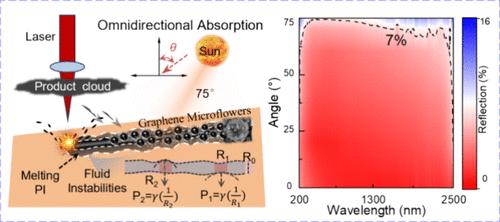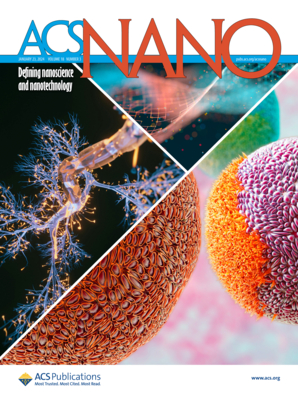Graphene Microflower by Photothermal Marangoni-Induced Fluid Instability for Omnidirectional Broadband Photothermal Conversion
IF 15.8
1区 材料科学
Q1 CHEMISTRY, MULTIDISCIPLINARY
引用次数: 0
Abstract
2-D carbon-based materials are well-known for their broadband absorption properties for efficient solar energy conversion. However, their high reflectivity poses a challenge for achieving efficient omnidirectional light absorption. Inspired by the multilevel structures of the flower, a Graphene Microflower (GM) material with gradient refractive index surface was fabricated on polymer substrates using the UV-intense laser-induced phase explosion technique under the synergistic design of the photothermal Marangoni effect and the fluid instability principle. The refractive index gradient reduces light reflection and absorbs at least 96% of light at incident angles of 0–60° across the entire solar wavelength range (200–2500 nm). Over 90% absorption even at 75° angle of incidence. The light absorption is enhanced by the multiple interferometric phase cancelation and localized surface plasmon resonance, resulting in a steady-state temperature 60 °C higher than ambient conditions under one solar irradiation. The max rate of temperature rise can reach up to 62 °C s–1. The device is then integrated at the hot end of the temperature difference generator at high altitude to ensure continuous and efficient power generation, producing a steady-state power of 196 mW.

通过光热马兰戈尼诱导的流体不稳定性实现石墨烯微花,从而实现全向宽带光热转换
二维碳基材料以其用于高效太阳能转换的宽带吸收特性而闻名。然而,它们的高反射率给实现高效的全向光吸收带来了挑战。受花朵多层次结构的启发,在光热马兰戈尼效应和流体不稳定性原理的协同设计下,利用紫外强激光诱导相爆技术在聚合物基底上制备了具有梯度折射率表面的石墨烯微花(GM)材料。折射率梯度减少了光反射,在整个太阳光波长范围(200-2500 nm)内,0-60° 入射角至少吸收 96% 的光。即使入射角度为 75°,吸收率也超过 90%。多重干涉相位抵消和局部表面等离子体共振增强了光吸收,使得在一次太阳照射下的稳态温度比环境温度高 60 °C。最大升温速率可达 62 °C s-1。然后,将该装置集成到高空温差发生器的热端,以确保持续高效地发电,产生 196 mW 的稳态功率。
本文章由计算机程序翻译,如有差异,请以英文原文为准。
求助全文
约1分钟内获得全文
求助全文
来源期刊

ACS Nano
工程技术-材料科学:综合
CiteScore
26.00
自引率
4.10%
发文量
1627
审稿时长
1.7 months
期刊介绍:
ACS Nano, published monthly, serves as an international forum for comprehensive articles on nanoscience and nanotechnology research at the intersections of chemistry, biology, materials science, physics, and engineering. The journal fosters communication among scientists in these communities, facilitating collaboration, new research opportunities, and advancements through discoveries. ACS Nano covers synthesis, assembly, characterization, theory, and simulation of nanostructures, nanobiotechnology, nanofabrication, methods and tools for nanoscience and nanotechnology, and self- and directed-assembly. Alongside original research articles, it offers thorough reviews, perspectives on cutting-edge research, and discussions envisioning the future of nanoscience and nanotechnology.
 求助内容:
求助内容: 应助结果提醒方式:
应助结果提醒方式:


